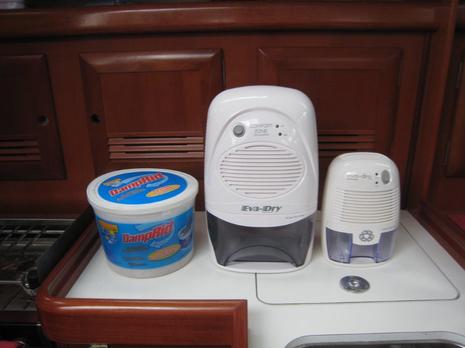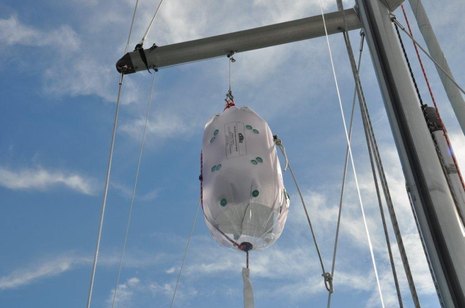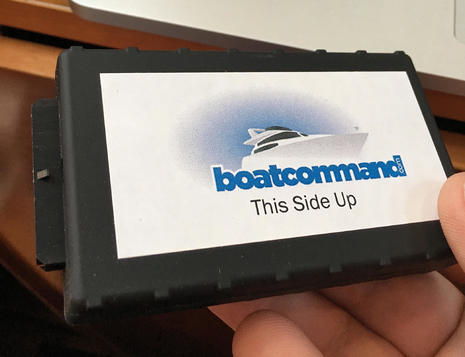Eva-Dry your boat interior
 One of the products above has proven itself a far superior option in keeping my 39-foot sailboat pleasantly dry and odor free, despite an occasional need to close up the boat with wet sails or gear down below.
One of the products above has proven itself a far superior option in keeping my 39-foot sailboat pleasantly dry and odor free, despite an occasional need to close up the boat with wet sails or gear down below.
When I first purchased Breeze Pleeze, I read a great article in support of using continuous airflow assisted by solar driven fans. The article promoted the use of two fans, one on each end of the boat, forcing air in one end and out the other. It sounded like the way to go, but I was not keen on blocking the view through a couple of hatches and resisted the temptation to follow that advice.
Inspired by a neighbor who kept a large home humidifier on his boat, I tried the much smaller Eva-Dry 1100 pictured above and below. Despite drilling a hole in the reservoir so the contents would endlessly spill into the galley sink, it didn’t initially seem to make a difference. I suspected the airflow between my companionway hatch and dorade vent was effectively replacing all the humidity the Eva-Dry was slowly pulling out of the air.
I improved upon this greatly by blocking most of the vent holes in my companionway hatch. As evident from a digital moisture meter, and by the bone-dry feeling of the air each time we returned to the boat, I was in business. Compared to a large, heavy humidifier I would need to leave behind on the dock, this tiny unit was easy to tuck away inside the boat.
It was almost a great solution, but the product failed every six months of use, signing off in a fit of loud, grinding noise.
 After going through three of them, I took a chance on the larger model after a reviewer on Amazon.com wrote that it was more reliable. The larger 2200 model pictured above lasted four years until its recent replacement. It is still small enough to easily store while underway. With the collection container being much larger, I have not yet encountered the need to drill a hole for continuous draining. Although it initially fills halfway pretty fast, keeping the vents on the companionway closed allows the reservoir to last about 7-10 days. And as a bonus to keeping the reservoir in tact, I have a continuous source of water ideal for filling batteries.
After going through three of them, I took a chance on the larger model after a reviewer on Amazon.com wrote that it was more reliable. The larger 2200 model pictured above lasted four years until its recent replacement. It is still small enough to easily store while underway. With the collection container being much larger, I have not yet encountered the need to drill a hole for continuous draining. Although it initially fills halfway pretty fast, keeping the vents on the companionway closed allows the reservoir to last about 7-10 days. And as a bonus to keeping the reservoir in tact, I have a continuous source of water ideal for filling batteries.
An unexpected benefit of the larger product is that the boat stays dry for some time after the product shuts down, measured at 45% on my digital meter (the product is capable of getting humidity down to about 45% before it stops functioning). Perhaps due to the moisture being sucked out of the cushions and everything else, the boat has some capacity to absorb new moisture before a damp feeling intrudes.
 Comparatively, it takes a lot of DampRid to do the same job. I found it takes about six 4-pound buckets open on Breeze Pleeze to put a dent in the water removal capability of the smaller Eva-Dry and that’s just a dent. Those six buckets don’t remove as much as the 8 ounces per day by the smaller Eva-Dry 1100.
Comparatively, it takes a lot of DampRid to do the same job. I found it takes about six 4-pound buckets open on Breeze Pleeze to put a dent in the water removal capability of the smaller Eva-Dry and that’s just a dent. Those six buckets don’t remove as much as the 8 ounces per day by the smaller Eva-Dry 1100.
The June 2013 issue of Practical Sailor has an in-depth evaluation of wired and chemical dehumidifiers. One of the many highlights in the article is a table comparing products, which includes a column for cost per pint. The Eva-Dry 2200 is listed as $1.28 per pint compared to the DampRid at $2.24 per pint. In the table, the chemical based alternatives have nothing going for them performance-wise, except they don’t require power. In their review of the Eva-Dry 2200, PS explains the technology behind it and provides many tips for its use. For example, they suggest placing the unit on the stove and the power supply in the galley sink, precautions appropriate for leaving electrical devices unattended.
This type of dehumidifier utilizies thermo-electric / Peltier technology. An electric current is passed through two dissimilar metals which transfer heat, and this causes the same effect that is used by compression technology. Although much less energy efficient than compressor dehumidifiers, there are many fewer parts making them effective for smaller areas like a boat, if you cut off the circulation to outside air.
The Eva-Dry 2200 cost about $95 and is available in versions powered either with DC (drawing a whopping 6 amps) or 110 volts (drawing less than 0.75 amps). On the surface, the 12v version is boat appropriate. However, the benefit of keeping with the 110 volt model is the assurance that if dock power is lost, the unit will shut down, rather than drain the house batteries.
– Dan Corcoran is an avid sailor and leads ServiceSPAN, a software and services company focused on finding and solving inefficiencies in the manual processes of corporate back offices.














A dockmate suggested a humidity control strategy of which I otherwise would have been completely unaware. My marine A/C system, apparently like most, has a humidity control mode, which as I understand it cycles the A/C on and off not to maintain temperature but instead to reduce A/C. It works fine (although I am not often in really humid environments), and its automatic cycling saves energy as compared to just leaving the A/C on.
These are a great way to go. I used a couple of the smaller units for years, replacing the fan when the “grinding noise” started but now exclusively use the larger ones with no problem.
I have one in the saloon, one in the master cabin, and one in the engine room. Have to empty them about once a week in the Pacific northwest.
The waste water from these units kill batteries (been there, done that). It is not filtered at all and contains a lot of previously airborne dirt.
Rick, you should take a look at the manual for your A/C control. If it is like mine, there are adjustments you can make to the dehumidification cycle to control how often the unit runs, the fan speed, and for how long it runs each time it comes on. You might even have a humidity sensor in the system and be able to set it.
I wish I had one of those Eva-Dry units back when I had a sailboat and had to put wet sails below on rainy days.
had to laugh at the “whopping 6 amps” draw at 12v, but apparently the .75 amp draw at 110v is no big deal? turns out the power draw on the 110v is over 10 watts higher than the 12v draw (82.5w vs 72w – assuming the listed amps are accurate). recommend always using power instead of amps or voltage to make comparisons like this.
I was misunderstood, in quite a different way jc. I didn’t intend to provoke any thoughts that an AC or DC implimentation is more efficient than the other. If I was, your right, watts would be much better way to express that .. and it would be unhelpful that I rounded numbers.
In fact the same amount of power is used either way. The AC to DC conversion losses just happen in different places. (AC to DC transformer at the Eva-Dry, vs. AC to DC transformer in the boat battery charger)
Rather what I meant to communicate using current is that 0.75 amps is no big deal when the boat is connected to dock power, likely there is pleanty of overhead left in your 30A or 50A dock connection for your other AC loads such as your battery charger.
6 amps is a big deal when your running something continuously off your batteries. Such a load can bring even a fair size battery bank to it’s knees before the humidity is removed, and is certainly not appropriate for a boat on a mooring.
Cheers
Just read a slew of very negative reviews on the Eva Dry 2200 unit at Amazon.com.
Problem seems to be major overheating of the AC adapter.
Based on these reviews, I would be reluctant to buy one.
Yes, the AC adapter gets very warm, but I have laptop computer AC adapters that are equal to it.
And where does he water go? If a dehumidifier removes 3 gallons of water a week, what does that device do?
If it simply evaporates a small amount of moisture, it really isn’t removing it from the “system”
I would thing here isn’t a substitute for decent ventilation — a except in extremely humid environments; and there, if you have power, then a traditional AC unit really would work.
Seems like Algae X, to me.
SG, the Eva-Dry 2200 can capture “approximately 20.5 oz. of water per day at 86° F and 80% R.H” and has a 2 liter water tank — illustrated nicely in Dan’s middle photo — and a level switch that turns the unit off if the tank gets full. If you’re going to be away from the boat longer, you can drill a hole in the tank and place the whole unit in the boat’s sink, as Dan illustrated in the third photo.
Or, then again, you can just go on dissing products without even reading the associated entry and product links 😉
Note, in addition to closing most of the vent holes on the companionway hatch, the dorade is closed up as well.
The inefficient power adapter is exactly why the complaints are about the power adapter failing – it’s turning that missing 10.5 watts into heat. Since it is a 12v device, it is easy to find a more reliable power supply for it if you don’t have the battery charger capacity (or want) to run it off DC. You can always unplug or switch it off while off shore power.
Seems like it would be easy to mount and plumb a small piece of tubing into a small thru-hull for a permanent, worry-free installation.
When you consider Damp-Rid’s price, also consider that it’s simply calcium chloride… and those of us in northern states can buy 20 pounds of it for a couple bucks. 🙂
I question the wisdom of using the condensate to top off your batteries. Along with the humidity there’s an encyclopedic array of particulates and organic matter suspended in the air and some of it is doubtlessly captured in the container – not to mention aluminum and aluminum oxide particles that shed from the units cooling plate.
While – in a crisis – I might be tempted to drink it, unless there is a first rate, no options emergency, I’ll continue to treat my batteries to good old distilled H2O.
I bought one of the larger units on the strength of your recommendation. It works very well to keep the boat dryer than ever, except that the AC adapter gets scary hot and, I am quite sure, will die sooner rather than later. Right now I have it placed onto the stainless-steel stove top in case it overheats and melts, but very soon I will have to find an alternative adapter.
I store my tri in a barn over the winter, and have used the smaller unit for years. Yes, the fan fails but can be replaced from an online electronics store. I pull my depth sounder probe and run a small tube through it attached to the bottom of the tank.
This year it will run an hour each day using a cheep timer. That should keep the humidity down and extend the fan life (and lower the heat on the AC converter.)